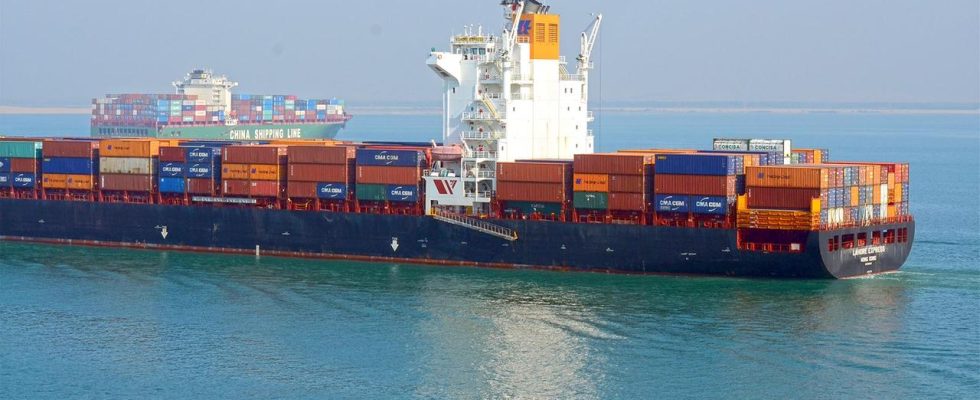Given the ongoing conflict in the Middle East, international container shipping continues to avoid the Red Sea and the Suez Canal. The global crises are also leaving their mark on German seaports.
The slight recovery in international container shipping in the Red Sea is already a thing of the past. After the number of daily container ships had risen again to around 50, it is currently around 40, close to the low point of mid-January. For comparison: Last year, on average, significantly more than 100 ships passed through the Red Sea every day.
This comes from the most recent Kiel Trade Indicator of the Institute for the World Economy (IfW) out. The barometer evaluates the global position data of container ships in real time. Based on their data, the Kiel researchers come to the conclusion: “The collapse in shipping traffic in the Red Sea since the attacks by the Houthi rebels has apparently not yet stopped.”
Cape of Good Hope instead of the Red Sea
Yemen’s Houthis have repeatedly attacked cargo ships near the Red Sea in response to Israel’s military offensive in the Gaza Strip. Instead of going through the Red Sea, many ships are now sailing around Africa. According to the IfW, the number of ships around the Cape of Good Hope has tripled within a year.
According to the institute’s assessment, because of the detour, shipping companies are now probably using more ships in order to be able to guarantee tight port schedules. The number of container ships that are at sea every day increased slightly by 0.3 percent from January to February and is currently around 5,450 ships.
Researchers give the all-clear
What consequences does this have for German ports and the German economy? The government advisors from the IfW explained that no negative consequences are to be expected for the economy as a whole and specifically for the German economy. “Both the freight rates to Europe and the volume of goods arriving in the North Sea are stabilizing.”
Initially, attacks on commercial shipping by the Iran-backed Houthi militia disrupted the usual sea route through the Suez Canal and caused two-week delays due to the detour around Africa. The frequency of ships in the ports is now returning to normal.
Freight rates are normalizing
According to the institute, around 25 percent fewer ships docked in Hamburg, Bremerhaven, but also in Rotterdam and Antwerp in December 2023 and January of this year. This gap reduced to around 15 percent in February. Bremerhaven is even up two percent.
The freight rates for the transport of a standard container from China to Northern Europe had also recently stabilized. Since peaking in mid-January at almost 5,500 euros (6,000 US dollars) per container, the spot price has fallen continuously to currently around 4,100 euros (4,500 US dollars).
Researcher: Germany needs to position itself more broadly when it comes to supply chains
“Even if the overall economic consequences are manageable: The renewed interruption of usual trade routes in the bottleneck of the Red Sea meets with a sensitized mood for geoeconomic risks and dependencies,” said Julian Hinz, research director and head of the Kiel Trade Indicators at IfW Kiel.
Germany and Europe are so economically prosperous precisely because, as open economies, they live from trade. “So it has to be about diversification, not about isolation.” That’s why we need to expand our supply chains and trading partners in order to reduce dependencies on individual suppliers, countries and also trade routes.
Seaports are feeling the effects of weak foreign trade
Overall, the global crises of 2023 have left a clear mark on German seaports. Their goods throughput fell by 4.1 percent to 267.8 million tons in 2023, as the Federal Statistical Office announced today in Wiesbaden. The minus hit all important seaports to varying degrees. An exception is the largest Baltic Sea port of Rostock, which, according to statisticians, particularly benefited from a sharp increase in crude oil throughput.
The two most important partner countries in maritime trade last year were the USA with a cargo turnover of 27.9 million tonnes and Norway with 25.1 million tonnes. “In 2022, Sweden replaced the Russian Federation as the most important partner country up to that point and was in third place in 2023 with 23.0 million tons of goods handled, followed by China in fourth place with 20.1 million tons,” said the statisticians.
“The increased deliveries of fossil fuels by the USA as a result of Russia’s war of aggression against Ukraine contributed to the shifts in the ranking of the most important partner countries.”
Container handling dropped again
According to the information, container throughput at German seaports in 2023 was 8.5 percent below the previous year’s value at 12.7 million 20-foot standard containers (TEU). “This was the second decline in container throughput in a row. The pre-crisis level of 2019 of 15.0 million TEU has not yet been reached again.”

